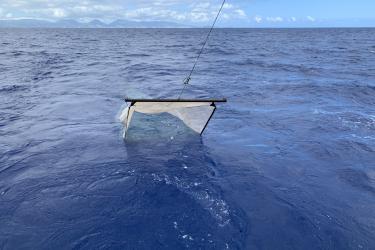It might surprise some people that the main Hawaiian Islands and Papahānaumokuākea Marine National Monument together span a total of roughly 1,700 miles in length. From Oʻahu, it took four days and about 800 miles to reach the first stop, Laysan Island. By that time our crew was ready to get to work!
Laysan Island, or Kamole in Native Hawaiian, is about approximately 1 mile wide by 1.5 miles long, with a hypersaline lake in the middle that features the world’s rarest duck, the endangered Laysan Duck. Twenty species of birds nest and inhabit this small, remote island, so keeping it clean remains a high priority! NOAA’s marine debris technicians launched their boats early for a full day of shoreline debris removal. They walked along the beach edge from north to south and collected anything that posed an entanglement hazard. Items of greatest concern are lines, nets, ropes, and circular hooped objects like eel trap funnels and plastic rings. These items are particularly hazardous to wildlife as Hawaiian monk seals, turtles, and seabirds can become entangled and trapped in debris wrapped around their fins/flippers, heads and wings. This can cause the animal permanent damage or even lead to death.
We quickly got to work pulling, digging, and yanking any large nets tangled in the shoreline shrubs or buried in sand from previous storms. Once the nets were freed, we loaded them onto the boats. The crew pulled 5,195 pounds of debris off the shoreline in just one hot, sunny, and exhausting day!
This was an incredible experience for all, but many team members were stepping onto Laysan Island for their first time, and the volume of plastics and anthropogenic products was a harsh reality. The beaches were clear of nets and entanglement hazards for the near future, but buoys, baskets, and bottles were still left on shore. Sarah Matye, a first-year marine debris technician, said of the experience: “I felt like collecting everything off the beach. Glass bottles everywhere, buoys, nets, toys and shipping container items. I wanted to take it all but there was just no way for us to accomplish this in a day. It was definitely heartbreaking.”
Though we can’t collect all the debris, we were grateful to fill our four workboats to the brim with nets and ropes! When we got back to the ship, the large crane onboard immediately started pulling up the huge loads with lifting straps. We set cargo nets on the floorboards of the boats at the beginning of each day. When they are hauled out with the crane, it really highlights the volume of debris we can grab with even just one boat!
After a long but successful day collecting our first piles of nets, the team was ready for the next adventure—in-water derelict fishing net surveys and removal operations at Maro Reef!







